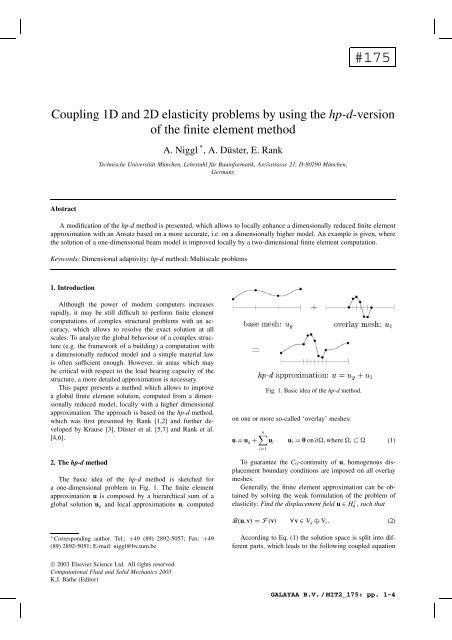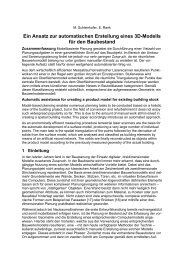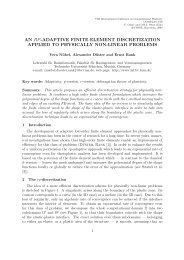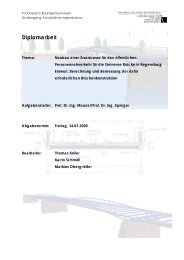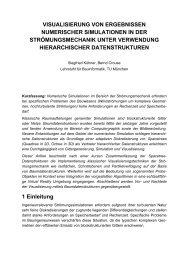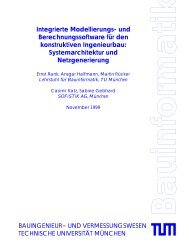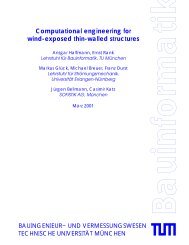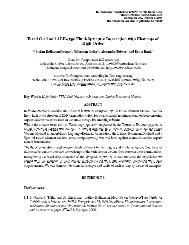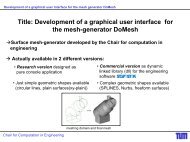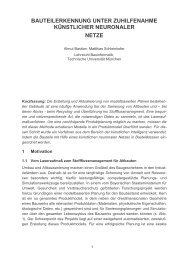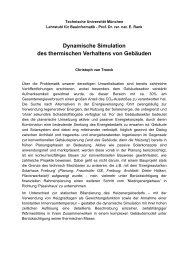Coupling 1D and 2D elasticity problems by using the hp-d-version of ...
Coupling 1D and 2D elasticity problems by using the hp-d-version of ...
Coupling 1D and 2D elasticity problems by using the hp-d-version of ...
Create successful ePaper yourself
Turn your PDF publications into a flip-book with our unique Google optimized e-Paper software.
#175<strong>Coupling</strong> <strong>1D</strong> <strong>and</strong> <strong>2D</strong> <strong>elasticity</strong> <strong>problems</strong> <strong>by</strong> <strong>using</strong> <strong>the</strong> <strong>hp</strong>-d-<strong>version</strong><strong>of</strong> <strong>the</strong> finite element methodA. Niggl * ,A.Düster,E.RankTechnische Universität München, Lehrstuhl für Bauinformatik, Arcisstrasse 21, D-80290 München,GermanyAbstractA modification <strong>of</strong> <strong>the</strong> <strong>hp</strong>-d method is presented, which allows to locally enhance a dimensionally reduced finite elementapproximation with an Ansatz based on a more accurate, i.e. on a dimensionally higher model. An example is given, where<strong>the</strong> solution <strong>of</strong> a one-dimensional beam model is improved locally <strong>by</strong> a two-dimensional finite element computation.Keywords: Dimensional adaptivity; <strong>hp</strong>-d method; Multiscale <strong>problems</strong>1. IntroductionAlthough <strong>the</strong> power <strong>of</strong> modern computers increasesrapidly, it may be still difficult to perform finite elementcomputations <strong>of</strong> complex structural <strong>problems</strong> with an accuracy,which allows to resolve <strong>the</strong> exact solution at allscales. To analyze <strong>the</strong> global behaviour <strong>of</strong> a complex structure(e.g. <strong>the</strong> framework <strong>of</strong> a building) a computation witha dimensionally reduced model <strong>and</strong> a simple material lawis <strong>of</strong>ten sufficient enough. However, in areas which maybe critical with respect to <strong>the</strong> load bearing capacity <strong>of</strong> <strong>the</strong>structure, a more detailed approximation is necessary.This paper presents a method which allows to improvea global finite element solution, computed from a dimensionallyreduced model, locally with a higher dimensionalapproximation. The approach is based on <strong>the</strong> <strong>hp</strong>-d method,which was first presented <strong>by</strong> Rank [1,2] <strong>and</strong> fur<strong>the</strong>r developed<strong>by</strong> Krause [3], Düster et al. [5,7] <strong>and</strong> Rank et al.[4,6].2. The <strong>hp</strong>-d methodThe basic idea <strong>of</strong> <strong>the</strong> <strong>hp</strong>-d method is sketched fora one-dimensional problem in Fig. 1. The finite elementapproximation u is composed <strong>by</strong> a hierarchical sum <strong>of</strong> aglobal solution u g <strong>and</strong> local approximations u i computedFig. 1. Basic idea <strong>of</strong> <strong>the</strong> <strong>hp</strong>-d method.on one or more so-called ‘overlay’ meshes:u = u g +n∑u i u i = 0 on∂ i where i ⊂ (1)i=1To guarantee <strong>the</strong> C 0 -continuity <strong>of</strong> u, homogenous displacementboundary conditions are imposed on all overlaymeshes.Generally, <strong>the</strong> finite element approximation can be obtained<strong>by</strong> solving <strong>the</strong> weak formulation <strong>of</strong> <strong>the</strong> problem <strong>of</strong><strong>elasticity</strong>: Find <strong>the</strong> displacement field u ∈ H0 1 , such thatB(u,v) = F (v) ∀v ∈ V g ⊕ V i . (2)∗ Corresponding author. Tel.: +49 (89) 2892-5057; Fax: +49(89) 2892-5051; E-mail: niggl@bv.tum.beAccording to Eq. (1) <strong>the</strong> solution space is split into differentparts, which leads to <strong>the</strong> following coupled equation© 2003 Elsevier Science Ltd. All rights reserved.Computational Fluid <strong>and</strong> Solid Mechanics 2003K.J. Ba<strong>the</strong> (Editor)GALAYAA B.V. / MIT2_175: pp. 1-4
2 A. Niggl et al. / Second MIT Conference on Computational Fluid <strong>and</strong> Solid Mechanicssystem (only one overlay mesh is assumed):B(u g + u 1 ,v g ) = F (v g ) ∀v g ∈ V g(3)B(u g + u 1 ,v 1 ) = F (v 1 ) ∀v 1 ∈ V <strong>1D</strong>ue to its linearity, we can split <strong>the</strong> bilinear form B(·,·)<strong>and</strong> bring <strong>the</strong> mixed terms to <strong>the</strong> right h<strong>and</strong> side. Theresulting equation system can <strong>the</strong>n be solved <strong>by</strong> applying ablock Gauss–Seidel iteration:B(u (k+1)g,v g ) = F (v g ) − B(u (k)1 ,v g)B(u (k+1)1,v 1 ) = F (v 1 ) − B(u (k+1)g,v 1 )The mixed terms in Eq. (4), e.g.∫B(u (k)1 ,v g) = ε(v g ):σ(u (k)1 )d= 1 ∩ g∫ 1 ∩ g(4)ε(v g ):C : ε(u (k)1)d (5)can be interpreted as an additional negative load vectorresulting from <strong>the</strong> stresses σ(u (k)1 )or<strong>the</strong>strainsε(u(k) 1 )<strong>of</strong><strong>the</strong> previous iteration step. The advantage <strong>of</strong> this approachis that no complicated quadrature scheme has to be appliedto compute <strong>the</strong> coupled stiffness matrix explicitly. We<strong>the</strong>refore only have to transfer <strong>the</strong> results from one mesh to<strong>the</strong> o<strong>the</strong>r one <strong>and</strong> apply <strong>the</strong>m as prestresses (or prestrains)to <strong>the</strong> actual iteration step.3. <strong>Coupling</strong> <strong>1D</strong> <strong>and</strong> <strong>2D</strong> <strong>problems</strong>Generally, <strong>the</strong>re is no reason that <strong>the</strong> different termsin Eq. (1) have to be computed with <strong>the</strong> same method.Therefore one can choose <strong>the</strong> global approximation u g ,such that it allows a cheap analysis, based, for example,on a dimensionally reduced model, which represents <strong>the</strong>global behaviour <strong>of</strong> <strong>the</strong> structure accurately enough. Onlyin areas, where <strong>the</strong> model error exceeds a certain limit,<strong>the</strong> solution is extended locally <strong>by</strong> a higher dimensionalAnsatz.In this paper, <strong>the</strong> global approximation u <strong>1D</strong>gis computedfrom a one-dimensional beam model. In <strong>the</strong> case<strong>of</strong> uniaxial bending, <strong>the</strong> solution is given <strong>by</strong> <strong>the</strong> three independentvariables u(x),w(x),(x), i.e. <strong>the</strong> longitudinaldisplacement, <strong>the</strong> deflection <strong>and</strong> <strong>the</strong> rotation, respectively.In areas where a critical model error is to be expected,a two-dimensional mesh is defined locally. The <strong>1D</strong> solutionis extended via <strong>the</strong> kinematic model assumptions to <strong>the</strong>two-dimensional case <strong>and</strong> applied to all integration points<strong>of</strong> <strong>the</strong> overlay mesh:( )( )u <strong>2D</strong>g (x, y) = ux (x, y) −(x)y + u(x)(6)u y (x) w(x)From this displacement field <strong>the</strong> strainsε(u <strong>2D</strong>g ): ε x = ∂u x∂x , ε y = 0, γ = ∂u x∂y + ∂u y(7)∂xare computed, acting as negative loads to <strong>the</strong> second part <strong>of</strong>Eq. (4)∫B(u 1 ,v 1 ) = F (v 1 ) − ε(v 1 ):C : ε(u <strong>2D</strong>g). (8) 1Solving this equation system, we obtain <strong>the</strong> approximationu <strong>2D</strong>1on <strong>the</strong> overlay mesh, which is added to u <strong>2D</strong>g .Generally, <strong>the</strong> overlay solution u <strong>2D</strong>1must be projected to <strong>the</strong>dimensionally reduced model in order to calculate <strong>the</strong> nextiteration step, see Eq. (4). However, numerical tests haveshown that this iteration is <strong>of</strong>ten not necessary in practice.Only one iteration step is needed to obtain an accurateextension to <strong>the</strong> dimensionally reduced, global solution.4. Numerical exampleIn <strong>the</strong> following example we consider a linear elasticbeam with two holes. The beam <strong>of</strong> length l, thicknessb <strong>and</strong> height h is clamped at both ends <strong>and</strong> loaded <strong>by</strong>an uniform pressure p = 1MN/m 2 . Figure 2 shows <strong>the</strong>one-dimensional model <strong>of</strong> <strong>the</strong> structure.Assuming <strong>the</strong> Bernoulli <strong>the</strong>ory for beam bending, ananalytical solution for <strong>the</strong> deflection w(x) <strong>and</strong> <strong>the</strong> rotation(x) can be given <strong>by</strong>w(x) = 124EI pl2 x 2 − 112EI plx3 + 124EI px4 ,(x) = ∂w∂x , (9)where E denotes Young’s modulus <strong>and</strong> I = bh 3 /12 represents<strong>the</strong> moment <strong>of</strong> inertia. The procedure to improve<strong>the</strong> <strong>1D</strong> solution in <strong>the</strong> vicinity <strong>of</strong> <strong>the</strong> left hole is sketchedin Fig. 3. The first mesh shows <strong>the</strong> stress σ x <strong>of</strong> <strong>the</strong> <strong>1D</strong>Fig. 2. One dimensional model <strong>of</strong> <strong>the</strong> beam with two holes.GALAYAA B.V. / MIT2_175: pp. 1-4
A. Niggl et al. / Second MIT Conference on Computational Fluid <strong>and</strong> Solid Mechanics 3Fig. 3. Improvement <strong>of</strong> <strong>the</strong> dimensionally reduced approximation in <strong>the</strong> vicinity <strong>of</strong> <strong>the</strong> left hole.beam solution in Eq. (9), extended to <strong>the</strong> two-dimensionalcase. Based on this solution, u 1 is computed on <strong>the</strong> overlaymesh according to Eq. (8). Finally, <strong>the</strong> composed solutionσ x (u) = σ x (u g ) + σ x (u 1 ) is shown at <strong>the</strong> bottom <strong>of</strong> <strong>the</strong>Fig. 3.The same approach can be used to ‘plaster’ incompatiblefinite element meshes <strong>of</strong> n local sub-models. Then Eq. (4)reads:∑B(u 1 ,v 1 ) = F (v 1 ) − B(u g ,v 1 ) − n B(u j ,v 1 )j≠1...∑B(u i ,v i ) = F (v i ) − B(u g ,v i ) − n B(u j ,v i )j≠i(10)Each single overlay problem can be computed <strong>the</strong>re<strong>by</strong>completely independently.Figure 4 illustrates this technique for <strong>the</strong> previouslypresented example. The solution at <strong>the</strong> hole on <strong>the</strong> righth<strong>and</strong> side <strong>of</strong> <strong>the</strong> beam is computed on a different mesh. Itis not necessary that <strong>the</strong> two overlay meshes must coincideon <strong>the</strong>ir boundaries, <strong>the</strong>y even can be overlapping.5. ConclusionsThe method presented in this paper allows a computationallycheap ‘level-<strong>of</strong>-detail’ analysis <strong>using</strong> a hierarchy <strong>of</strong>models. Considering more complex structural <strong>problems</strong>, itallows to analyze special details <strong>of</strong> <strong>the</strong> structure independently,based on a global ‘background’ solution only. Thesame technique can be used to couple higher dimensionalFig. 4. Improvement <strong>of</strong> <strong>the</strong> <strong>1D</strong> beam approximation <strong>by</strong> two independent overlay solutions, stresses σ x is plotted.GALAYAA B.V. / MIT2_175: pp. 1-4
4 A. Niggl et al. / Second MIT Conference on Computational Fluid <strong>and</strong> Solid Mechanicsmodels or to apply different material models on each level<strong>of</strong> detail.Finally, an improvement <strong>of</strong> <strong>the</strong> method could beachieved <strong>by</strong> applying an a-posteriori error estimator whichhelps to detect <strong>the</strong> model error <strong>of</strong> <strong>the</strong> lower dimensionalapproximation. This would allow for an adaptive solutionscheme, which automatically enhances <strong>the</strong> solution in areas,where a significant model error occurs.References[1] Rank E. Adaptive remeshing <strong>and</strong> <strong>hp</strong> domain decomposition.Computer Methods in Applied Mechanics <strong>and</strong> Engineering1992; 101:299–313.[2] Rank E. A combination <strong>of</strong> <strong>hp</strong>-<strong>version</strong> finite elements <strong>and</strong> adomain decomposition method. In Proceedings <strong>of</strong> <strong>the</strong> FirstEuropean Conference on Numerical Methods in Engineering,Brüssel, 1992.[3] Krause R. Multiscale computations with a combined h-<strong>and</strong> p-<strong>version</strong> <strong>of</strong> <strong>the</strong> finite-element method. PhD Thesis,Fach Numerische Methoden und Informationsverarbeitung,Universität Dortmund, 1996.[4] Rank E, Krause R. A multiscale finite-element-method.Comput Struct 1997;64:139–144.[5] Düster A, Rank E, Steinl G, Wunderlich W. A combination<strong>of</strong> an h- <strong>and</strong>p-<strong>version</strong> <strong>of</strong> <strong>the</strong> finite element methodfor elastic-plastic <strong>problems</strong>. In: Proceedings <strong>of</strong> ECCM ’99,European Conference on Computational Mechanics 1999,München.[6] Rank E, Düster A. Dimensional adaptivity <strong>using</strong> <strong>the</strong> p-<strong>version</strong> <strong>of</strong> <strong>the</strong> finite element method. In: Proceedings <strong>of</strong> <strong>the</strong>European Conference on Computational Mechanics 2001,Cracow 2001.[7] Düster A. High order finite elements for three-dimensional,thin-walled nonlinear continua. PhD Thesis, Lehrstuhl fürBauinformatik, Technische Universität München, 2001.GALAYAA B.V. / MIT2_175: pp. 1-4


